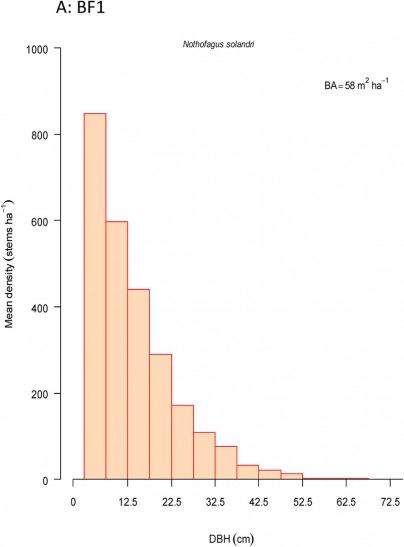Nothofagus solandri (Peraxilla tetrapetala) / Coprosma pseudocuneata) subalpine forest
In this section
Common name: Black/mountain beech forest (subalpine) Code: A: BF1
![Mountain beech with abundant [Coprosma pseudocuneata] in the understorey. Arthur's Pass National Park. Mountain beech with abundant [Coprosma pseudocuneata] in the understorey. Arthur's Pass National Park.](/assets/Publications/Woody-ecosystem-types/Mountain_beech_Coprosma_pseudocuneata_understorey_Arthurs_Pass_NP__ResizedImageWzQwNSwyNzBd.jpg)
Mountain beech with abundant [Coprosma pseudocuneata] in the understorey. Arthur's Pass National Park.
Where does it occur?
This 219 000 ha alliance was sampled on the South Island in montane areas east of the Main Divide. Sites are cool and range in altitude from 200 m in the south to 1520 m in the north and have the lowest mean annual temperatures (xˉ = 6.9 ± 0.23°C) of any forest alliance. This alliance occurs primarily on faces and ridges on steep slopes ranging from 11–45 degrees.
Description
The forest is dominated by Nothofagus solandri (in this instance var. cliffortioides), which has both the highest frequency and abundance in all height tiers, and is typically the only species above 2 m tall. The epiphyte Peraxilla tetrapetala is diagnostic; it is the second most frequent species, occurring on almost half of the plots. In the subcanopy (0.3 – 2 m) there are occasional occurrences of Coprosma pseudocuneata, C. tayloriae, Phyllocladus alpinus, silver beech, and Podocarpus nivalis.

Size structure of canopy dominants.
Frequent ground-layer species include those in the canopy and subcanopy as well as Blechnum penna-marina and Corybas trilobus. Species richness is the lowest of any alliance (average = 10 ± 0.9 species per plot)with five of these being woody tree or shrub species. Few exotic species are found in this class (mean = 1 per plot, range 0–3), and none of the individual species are particularly frequent (the most frequent, Mycelis muralis, occurred on 10% of plots). Fern richness is also low, with typically only one species present on each plot.
Stand characteristics
| Mean canopy height (m): | 14 m (range 2–27) |
| Mean stem density (stems/ha): | 2650 (383) |
| Mean basal area (m2/ha): | 59 (3.8) |
Synonyms
| Relationship | Name | Author |
|---|---|---|
| is included within | Mountain beech forest | Singers & Rogers (unpublished) |
| overlaps with | Beech forests: northern South Island | Wardle (1991) |
| overlaps with | [p. 152] Beech forests: North Island axial ranges | Wardle (1991) |
| overlaps with | [p. 147] Beech forests: Central and southern South Island | Wardle (1991) |
| broadly equivalent to | Silver, mountain beech beech forest | Singers & Rogers (unpublished) |
Nothofagus solandri / Polystichum vestitum – Blechnum penna-marina (Laginifera strangulata – Nemotoceras trilobum) forest
![The fern [Polystichum vestitum] beneath a canopy of [Nothofagus solandri] is typical of this association. Waimakiriri Basin, Canterbury. The fern [Polystichum vestitum] beneath a canopy of [Nothofagus solandri] is typical of this association. Waimakiriri Basin, Canterbury.](/assets/Publications/Woody-ecosystem-types/Polystichum_vestitum_canopy_Nothofagus_solandri_Waimakiriri-Basin_Canterbury__ResizedImageWzQwNSwyNzBd.jpg)
The fern [Polystichum vestitum] beneath a canopy of [Nothofagus solandri] is typical of this association. Waimakiriri Basin, Canterbury.
Common name: Black/mountain beech forest with hard fern and little hard fern
Code: a: BF1
Where does it occur?
This 83 200 ha association has been sampled on the South Island in montane areas east of the Main Divide. Sites range from flat to steeply sloping (60º). Altitudes range from 375 to 1380 m.
Description
On average stands are 16 m tall, but may be up to 27 m tall.These forests have, on average, 23 species, but can reach 46, recorded on a plot. Of these 11%, on average, are exotic, .
![The ferns [Blechnum penna-marina] and [Polystichum vestitum] commonly co-occur in stands of this association Image](/assets/Publications/Woody-ecosystem-types/aBF1_ferns-v2__FitMaxWzE1LDE1XQ.jpg)
![The fern [Polystichum vestitum] beneath a canopy of [Nothofagus solandri] is typical of this association. Waimakiriri Basin, Canterbury. Image](/assets/Publications/Woody-ecosystem-types/aBF1_Polystichum_vestitum_2__FitMaxWzE1LDE1XQ.jpg)
![The fern [Polystichum vestitum] beneath a canopy of [Nothofagus solandri] is typical of this association. Waimakiriri Basin, Canterbury. Image](/assets/Publications/Woody-ecosystem-types/aBF1_Polystichum_vestitum__FitMaxWzE1LDE1XQ.jpg)
Nothofagus solandri forest
Common name: Black/mountain beech forest
Code: a: BF2
Where does it occur?
This 53 000 ha association has been sampled on the South Island in montane areas east of the Main Divide and in the Kaimanawa range on the North Island. Sites range from flat to steeply sloping (45º). Altitudes range from 300 to 1520 m.
Description
On average stands are 14 m tall, but may be up to 65 m tall.These forests are very species-poor, with on average 4 species, and only up to 13, recorded on a plot. On average 4% of these are exotic.
Nothofagus solandri / Coprosma pseudocuneata – Phyllocladus alpinus (Podocarpus nivalis) subalpine forest
Common name: Mountain beech subalpine forest
Code: a: BF3
Where does it occur?
This 45 400 ha association has been sampled on the South Island in montane areas east of the Main Divide, in the Nelson-Marlborough region and in the Kaweka ranges on the North Island. Sites range from flat to steeply sloping (50º). Altitudes range from 585 to 1440 m.
Description
On average stands are 11 m tall, but may be up to 25 m tall.These forests are relatively species-poor, with on average 15 species, but can reach 37, recorded on a plot. Only 2% of these, on average, are exotic.
Known distribution maps




References
Wiser, S.K., Hurst, J.M. 2010. Composition and structure of 24 New Zealand forest and shrubland vegetation communities. Landcare Research Contract Report LC0910-073. Prepared for the Department of Conservation and the Sustainable Management Fund of the Ministry of Agriculture and Forestry.
Wiser, S.K., J.M. Hurst, R.B. Allen, E.F. Wright. 2011. New Zealand’s forest and shrubland communities: a classification based on a nationally representative plot network. Applied Vegetation Science 14: 506-523.
Wiser, S.K.; De Cáceres, M. 2013. Updating vegetation classifications: an example with New Zealand's woody vegetation. Journal of Vegetation Science 24: 80-93.
